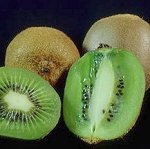


|
HOME EARLY SUMMER · Apples · Apricots · Apriums · Artichokes · Cherries · Figs · Grapes · Nectarines · Peaches · Plums · Pluots MID SUMMER · Apples · Artichokes · Asian Pears · European Prune-plums · Figs · Grapes · Mangos · Nectarines · Peaches · Pears · Plums FALL · Apples · Asian Pears · Grapes · Kiwi Fruit · Oranges · Pears · Persimmons · Pineapple · Plums · Pomegranates WINTER · Apples · Asian Pears · Avocados · Grapes · Grapefruit · Kiwi · Kumquats · Oranges · Pears · Strawberries · Tangerines COMPANY CONTACTS |
Kiwi Fruit Facts and Information | |
|
Browse our Gift Catalogs Availability by Variety Recipe Search & More Information | |
 KIWI FRUIT
, common name for a southeast-Asian vine, also called Chinese gooseberry and yangtao, and for its edible fruit. The small, oval fruit has a thin brownish-green skin with a fuzzy surface. The flesh, which is a distinctive green, with tiny purplish seeds surrounding a white core, may be eaten raw or cooked. KIWI FRUIT
, common name for a southeast-Asian vine, also called Chinese gooseberry and yangtao, and for its edible fruit. The small, oval fruit has a thin brownish-green skin with a fuzzy surface. The flesh, which is a distinctive green, with tiny purplish seeds surrounding a white core, may be eaten raw or cooked.The history of the kiwifruit began in the Chang Kiang Valley of China. Called Yang Tao, it was considered a delicacy by the great Khans who relished the fruit's brilliant flavor and emerald-green color. Knowledge of the fruit expanded to other countries in the mid 1800s to 1900s. A collector for the Royal Horticultural Society of Britain send samples home in 1847, and another send seeds to England in 1900. Plants were first exported from China to the United States in 1904, and seeds were brought to New Zealand in 1906. Kiwifruit is available worldwide today and is produced in New Zealand, the United States, Italy, Japan, France, Greece, Spain, Australia, and Chile. Due to California kiwifruit's late fall harvest, fresh kiwifruit is available to U.S. and Canadian consumers during the winter months, an uncommon time for the "homegrown" fresh fruits. With proper storage and handling, California kiwifruit is available for up to eight months - from October through May. How to Store: Store unripe kiwis at room temperature until skin indents slightly when touched. Place kiwi in a paper bag with an apple or banana, or in a ripening bowl to speed ripening. Ripe kiwis can be kept in the refrigerator for up to three weeks. Basic Nutritional Facts: According to recent studies, kiwifruit is the most nutrient dense of all the major fruits: Detailed nutritional informatin can be found by searching the USDA Nutritional Database. Enter "Kiwi" (no quotes) as the keyword and select the link and report of interest. Scientific classification: Kiwi fruit belongs to the family Actinidiaceae. It is classified as Actinidia chinensis. |
bof, 5856 E. Brown, Fresno, CA 93727 ¤ (559) 294-2070 ¤ (888) 903-7848 ¤ Fax: (559) 294-2086
ctg - WEB Development Team - Copyright © 2002 - all rights reserved